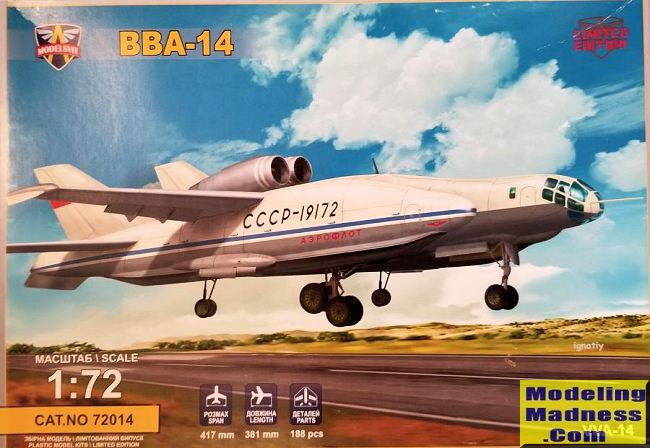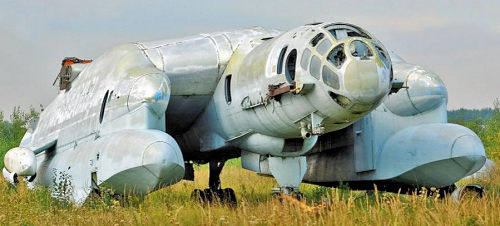
| KIT #: | 72014 |
| PRICE: | $52.00 |
| DECALS: | One option |
| REVIEWER: | Mark Hiott |
| NOTES: |

| HISTORY |
The Bartini Beriev VVA-14 was a wing-in-ground-effect aircraft developed in the Soviet Union during the 1970s. Designed to be able to take off from the water and fly at high speed over long distances, it was to make true flights at high altitude, but also have the capability of "flying" efficiently just above the sea surface, using aerodynamic ground effect.
Bartini, in collaboration with the Beriev Design Bureau intended to develop the prototype VVA-14 in three phases. The VVA-14M1 was to be an aerodynamics and technology testbed, initially with rigid pontoons on the ends of the central wing section, and later with these replaced by inflatable pontoons. The VVA-14M2 was to be more advanced, with two starting engines to blast into the cavity under the wing to give lift and later with a battery of lift engines to give VTOL capability, and with fly-by-wire flight controls. The VVA-14M3 would see the VTOL vehicle fully equipped with armament and with the Burevestnik computerised anti-submarine warfare (ASW) system, Bor-1 magnetic anomaly detector (MAD) and other operational equipment.
After extensive research, including the development of the small prototype Be-1
wing in ground effect aircraft, the first VVA-14 prototype was completed in
1972. Its first flight was from a conventional runway in September 1972. In
1974, the inflatable pontoons were installed, though their operation caused many
problems. Flotation and water taxi tests followed, culminating in the start of
flight testing of the amphibious aircraft on 11 June 1975. The inflatable
pontoons were later
 replaced
by rigid pontoons, while the fuselage was lengthened and the starting engines
added. This incarnation was given the designation 14M1P. However, the bureau
supplying the intended battery of 12 RD-36-35PR lift engines did not deliver,
and this made VTOL testing impossible.
replaced
by rigid pontoons, while the fuselage was lengthened and the starting engines
added. This incarnation was given the designation 14M1P. However, the bureau
supplying the intended battery of 12 RD-36-35PR lift engines did not deliver,
and this made VTOL testing impossible.
After Bartini's death in 1974, the project slowed and eventually drew to a close, the aircraft having conducted 107 flights, with a total flight time of 103 hours. The only remaining VVA-14, No. 19172, was retired to the Soviet Central Air Force Museum in 1987. The aircraft still resides at the museum in a dismantled state, where it carries the designations "10687" and "Aeroflot".
| THE KIT |
 Russia
built some crazy aircraft in the past! The VVS-14 is a fine example. Molded in a
somewhat brittle gray plastic, the kit contains 188 parts. It is also a decent
size with a 16in wingspan.
Russia
built some crazy aircraft in the past! The VVS-14 is a fine example. Molded in a
somewhat brittle gray plastic, the kit contains 188 parts. It is also a decent
size with a 16in wingspan.
The parts breakdown is a
little strange due to the aircraft's design and ma y
make for a rough seams. While there is no PE, it does include paint masks for
the clear parts.
y
make for a rough seams. While there is no PE, it does include paint masks for
the clear parts.
There is very little flash on the parts and detail, while a bit soft, is nice. The instructions are a 2 page foldout and include a nice color layout. The decals are well done and they appear to be crisp and clear.
| CONCLUSIONS |
It may be a rough build but will make an excellent addition to any display. It will certainly draw attention! I cannot recommend it for a beginner, but anyone who has done a few short run kits should have no problems.
| REFERENCES |
Wiki for the history
Internet for photos
July 2019
Copyright ModelingMadness.com If you would like your product reviewed fairly and
fairly quickly, please
contact
the editor
or see other details in the
Note to
Contributors.
Back to the Main Page
Back to the Review
Index Page
Back to the Previews Index Page